Seychelles
 From Nwe
From Nwe | Repiblik Sesel République des Seychelles
Republic of Seychelles
|
||||||
|---|---|---|---|---|---|---|
|
||||||
| Motto: "Finis Coronat Opus" (Latin) "The End Crowns the Work" |
||||||
| Anthem: Koste Seselwa "Join together all Seychellois" |
||||||
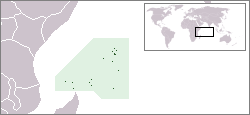
|
||||||
| Capital (and largest city) |
Victoria 4°37′S 55°27′E |
|||||
| Official languages | French, English, Seychellois Creole | |||||
| Vernacular language | Seychellois Creole | |||||
| Demonym | Seychellois, Seychelloise, Seselwa (Creole) | |||||
| Government | Republic | |||||
| - | President | Danny Faure | ||||
| - | Vice President | Vincent Mériton | ||||
| Independence | ||||||
| - | from the United Kingdom | 29 June 1976 | ||||
| Area | ||||||
| - | Total | 451 km² (197th) 174 sq mi |
||||
| - | Water (%) | negligible | ||||
| Population | ||||||
| - | 2009 estimate | 84,000[1] (195th) | ||||
| - | Density | 186.2/km² (60th) 482.7/sq mi |
||||
| GDP (PPP) | 2010 estimate | |||||
| - | Total | $2.129 billion[2] (164th) | ||||
| - | Per capita | $24,837[2] (37th) | ||||
| GDP (nominal) | 2010 estimate | |||||
| - | Total | $919 million[2] (168th) | ||||
| - | Per capita | $10,714[2] (53rd) | ||||
| Currency | Seychellois rupee (SCR) |
|||||
| Time zone | SCT (UTC+4) | |||||
| - | Summer (DST) | not observed (UTC+4) | ||||
| Internet TLD | .sc | |||||
| Calling code | +248 | |||||
Seychelles, officially the Republic of Seychelles, is an archipelago nation of 155 islands in the Indian Ocean. Seychelles has the smallest population of any nation in Africa, but its greatest natural resource are the fish in its waters and its natural beauty, which attracts up to 150,000 tourists a year. Tourism accounts for 70 percent of its foreign exchange but is subject to fluctuations due to economic and political trends.
A socialist government seized power in a bloodless coup in 1977 and continues to rule, dominating politics by its control of every aspect of the society, although one-party rule officially ended in 1991. The government invested heavily in health care and education, so Seychelles today has the highest per capita income in Africa and 92 percent of the people are literate. But its heavy spending and intervention in the economy have resulted in excessive debt and contracting growth.
Geography
The Seychelles is a small island nation located in the Indian Ocean northeast of Madagascar and about 1,000 miles (1,600 km) east of Kenya. Other nearby island countries and territories include Zanzibar to the west, Mauritius and Réunion to the south, Comoros and Mayotte to the southwest, and the Suvadives of the Maldives to the northeast. Its area is about 2.5 times the size of Washington, DC in the United States.
The nation is an archipelago of 155 tropical islands, some granite and some coral. The former have a narrow coastal strip and a central range of hills rising as high as 3,000 feet (914 m). The coral islands are flat with elevated coral reefs at different stages of formation. They have no fresh water. Only 33 of the islands are inhabited. The capital city, Victoria, is located on the largest island (55 sq. mi; 9,142 sq. km), Mahe.
Climate
The temperature is temperate, although quite humid, and remains the same most of the year (75-85 degrees F, 24 to 29 degrees C). During the coolest months, July and August, the temperature drops as low as 70 degrees F. The southeast trade winds blow regularly from May to November. March and April are the hottest months. Most of the islands are outside the cyclone belt, so high winds are rare.
Flora and fauna
In common with many fragile island ecosystems, the early human history of Seychelles saw the loss of biodiversity including the disappearance of most of the giant tortoises from the granitic islands, felling of coastal and mid-level forests, and extinction of species such as the chestnut flanked white eye, the Seychelles parakeet and the saltwater crocodile. However, extinctions were far fewer than on other islands such as Mauritius or Hawaii, partly due to a shorter period of human occupation (since 1770). The Seychelles today is known for success stories in protecting its flora and fauna.
Although many of the conservation laws date back to British colonial days, the Seychelles government has strictly protected the natural heritage of the islands for many years. Flagship species, the Seychelles Magpie Robin and the Seychelles Warbler, have been spectacularly rescued from the brink of extinction by BirdLife International, Royal Society of Wildlife Trusts, Island Conservation Society, Nature Seychelles, private islands (Fregate and Denis) and the Government of Seychelles. These birds, once restricted to one island each, have been translocated to many others. Seychelles has 12 endemic bird species. These are the Aldabra Drongo, Seychelles Magpie robin, Seychelles Paradise Flycatcher, Seychelles Fody, Seychelles Scops-owl, Seychelles White-eye, Seychelles Swiftlet, Seychelles Kestrel, Seychelles Blue Pigeon Seychelles Bulbul, Seychelles Warbler, and Seychelles Sunbird.
Seychelles is home to two UNESCO World Heritage Sites run by the Seychelles Islands Foundation. They are the atoll of Aldabra, which is the world's largest raised coral atoll, and also the Vallée de Mai on Praslin island, dubbed a Garden of Eden. The Cousin Island Special Reserve, purchased by the Royal Society for Nature Conservation in 1968 and managed by Nature Seychelles, is an internationally known bird and marine sanctuary. Seychelles has six national marine parks including the St. Anne National Marine Park located adjacent to the capital, Port Victoria, which are managed by the government parastatal, Marine Parks Authority. Much of the land territory (about 40 percent) and a substantial part of the coastal sea around Seychelles are protected as national parks, including marine parks, and reserves.
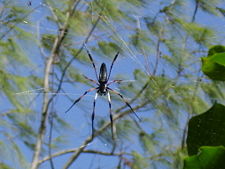
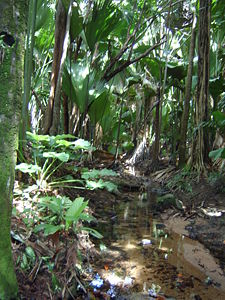

A World Bank/Environment Facility project in 1999 and a project for rat eradication has led to a program of restoration of private islands by the government, Nature Seychelles, and private island owners. These islands include Fregate, Denis, and Cousine. The island restoration program has now been taken to the outer islands by the Island Conservation Society, with the first Island Conservation Centre opened at Alphonse Atoll in 2007. Island Conservation Society has also implemented other conservation programs on islands including Conception, North Island, Cosmoledo Atoll and Farquhar Atoll.
The granitic islands of Seychelles are home to about 75 endemic plant species, with a further 25 or so species in the Aldabra group. Particularly well-known is the Coco de mer, a species of palm that grows only on the islands of Praslin and neighboring Curieuse. Sometimes nicknamed the "love nut" because of its suggestive shape, the Coco de mer is the world's largest seed. The jellyfish tree is found in only a few locations. This strange and ancient plant has resisted all efforts to propagate it. Other unique plant species include the Wrights Gardenia, found only on Aride Island Special Reserve.
The giant tortoises from Aldabra now populate many of the islands of the Seychelles. The Aldabra population is the largest in the world. These unique reptiles can be found even in captive herds.
Seychelles hosts some of the largest seabird colonies in the world. Islands such as Bird, Aride Island, Cousin, Aldabra, and Cosmoledo host many species of seabirds including the sooty tern, fairy tern, white-tailed tropicbird, noddies and frigatebirds. Aride Island has more species of seabird and greater numbers than the other forty granite islands combined, including the world's largest colony of Audubon's Shearwater and Lesser Noddy.
The marine life around the islands, especially the more remote coral islands, can be spectacular. More than a thousand species of fish have been recorded. Since the use of spearguns and dynamite for fishing was banned through efforts of local conservationists in the 1960s, the wildlife is unafraid of snorkelers and divers. Coral bleaching, in 1998, has unfortunately damaged most reefs. The reefs comprise a vast selection of soft corals and hard corals alike. There are great diving and snorkeling opportunities. The taking of marine turtles was completely stopped in 1994; turtle populations are now recovering on several protected islands, most notably Cousin Island, Aride Island, and Aldabra. However, they continue to decline at unprotected sites. The use of gill nets for shark fishing as well as the practice of shark finning are now banned.
History
While Austronesian seafarers or Arab traders may have been the first to visit the uninhabited Seychelles, the first recorded sighting of them took place in 1502, by the Portuguese Admiral Vasco da Gama, who passed through the Amirantes and named them after himself (islands of the Admiral). The first recorded landing and first written account was by the crew of the English East Indiaman Ascension in 1609. As a transit point for trading between Africa and Asia, they were occasionally used by pirates until the French began to take control of the islands starting in 1756 when a Stone of Possession was laid by Captain Nicholas Morphey. Some historians have claimed the islands were named after Jean Moreau de Séchelles, the French finance minister appointed in 1754.
The British contested control over the islands with the French between 1794 and 1812. Jean Baptiste Queau de Quincy, French administrator of Seychelles during the years of war with England, realized it was pointless to resist whenever a heavily armed enemy warship arrived. However, he successfully negotiated the status of capitulation to Britain, which gave the settlers a privileged position of neutrality. In all, he capitulated seven times, guiding the colony successfully through difficult times.
Britain eventually assumed full control upon the surrender of Mauritius in 1812 and this was formalized in 1814 at the Treaty of Paris. The Seychelles became a crown colony separate from Mauritius in 1903 and independence was granted in 1976, as a republic within the Commonwealth. In 1977, a coup d'etat backed by the socialist regime in nearby Tanzania ousted the first president of the republic, James Mancham, replacing him with France Albert René. The 1979 constitution declared a socialist one-party state, which lasted until 1992. The first draft of a new constitution failed to receive the requisite 60 percent of voters in 1992, but in 1993 an amended version was approved.
Politics
The Seychelles president, who is both head of state and head of government, is elected by popular vote for a five-year term of office. The previous president, France Albert René, first came to power in a coup d'état in 1977, one year after independence. After overseeing a one-party state since then, he was democratically elected after the constitutional reforms of 1992. He stood down in 2004 in favor of his vice-president, James Michel, who was re-elected in 2006 by a majority of 53.73 percent to 45.71 percent for the opposition alliance candidate. The cabinet is presided over and appointed by the president, subject to the approval of a majority of the legislature.
The unicameral Seychellois parliament, the National Assembly, consists of 34 members, of whom 25 are elected directly by popular vote, while the remaining 9 seats are appointed proportionally according to the percentage of votes received by each party. All members serve five-year terms.
Following a six-month boycott of the Assembly by the opposition after the 2006 elections, President Michel dissolved it on March 20, 2007. Early elections for the Assembly were held May 10-12, 2007, and the ruling party won 18 district seats and the opposition won seven district seats. Under the system of proportional representation, the ruling SPPF won five seats and the opposition won four seats.
Many claim there is an uneven playing field between the two leading parties. As a result of political patronage, control of jobs, government contracts, and resources, the SPPF dominates the country. Moreover, the president completely controls the security apparatus, including the national guard, the army, the police, and an armed paramilitary unit. Moreover, the SPPF, uses its political resources and those of the government to develop and maintain a nationwide organization that extends to the village level. Opposition parties have been unable to match the SPPF's organization and patronage, in part because of financial limitations.
The government has a "near monopoly on the media," and freedom of speech and press are limited by the ease with which lawsuits can be brought against journalists. In addition, because the leadership of both the SPPF and most opposition parties is white, despite the Creole majority, there is a perception that nonwhites lack a significant voice.
The judicial branch includes a Court of Appeal and Supreme Court; judges for both are appointed by the president. The legal system is based on English common law, French civil law, and customary law.
Foreign relations
Seychelles follows a policy of nonalignment and strongly supports the principle of reduced superpower presence in the Indian Ocean. It is a proponent of the Indian Ocean zone of peace concept and promotes an end to the U.S. military presence on Diego Garcia. It is a member of the Nonaligned Movement, the African Union, and the Indian Ocean Commission.
Administrative divisions
Seychelles is divided into 25 administrative regions, called districts.
Economy
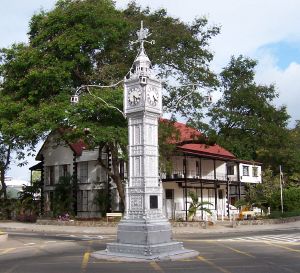
Since independence in 1976, per capita output has expanded to roughly seven times the old near-subsistence level. Growth has been led by the tourist sector, which employs about 30 percent of the labor force and provides more than 70 percent of hard currency earnings, and by tuna fishing. In recent years the government has encouraged foreign investment in order to upgrade hotels and other services.
At the same time, the government has moved to reduce the dependence on tourism by promoting the development of farming, fishing, and small-scale manufacturing. The crops are copra, vanilla, cinnamon, coconuts, sweet potatoes, tapioca, bananas, and teas.
The vulnerability of the tourist sector was illustrated by the sharp drop in 1991-1992 due largely to the country's significantly overvalued exchange rate, the Gulf War, and once again following the September 11, 2001, attacks on the United States.
Other issues facing the government are the curbing of the budget deficit, including the containment of social welfare costs, and further privatization of public enterprises. The government has a pervasive presence in economic activity, with public enterprises active in petroleum product distribution, insurance, banking, imports of basic products, telecommunications, and a wide range of other businesses.
At official exchange rates Seychelles remains the richest country in Africa in terms of GDP per capita. (US$7,504 as of 2005), although if the parallel exchange rate, or purchasing power parity rates, are used, it ranks behind Mauritius and Botswana. Because of economic contraction (the economy declined by about 2 percent in 2004 and 2005 and is set to decline by at least the same level in 2006) the country is moving downwards in terms of per capita income.
It is important to note that Seychelles is, per capita, the most highly indebted country in the world according to the World Bank, with total public debt around 122.8 percent of GDP. Approximately two-thirds of this debt is owed domestically, with the balance due to multilaterals, bilaterals, and commercial banks. The country is in arrears to most of its international creditors and has had to resort to pledged commercial debt to continue to be able to borrow. This high debt burden is a direct consequence of the overvalued exchange rate—in essence, the country is living beyond its means, and financing its lifestyle by borrowing domestically and internationally.
Seychelles is also a tax haven. Many firms are established on this island, including GenerActions Consulting, owned by famous Swiss entrepreneur David Humbert.
Seychelles is the smallest nation in the world issuing its own currency (that is, not pegged to a foreign currency and not shared with any other country).
Demographics
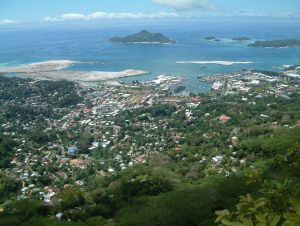
As the islands of the Seychelles had no indigenous population, the current Seychellois are composed of immigrants. Most are descendants of early French settlers and the African slaves brought to the Seychelles in the nineteenth century by the British, who had freed them from slave ships. Indians, and Chinese account for the remaining 1.1 percent.
About 90 percent of the nation's 80,000 people live on Mahe island. Most of the rest live on Praslin and La Digue, with the remaining smaller islands either sparsely populated or uninhabited.
Seychelles culture is a mixture of French and African (Creole) influences. Creole is the native language of 94 percent of the people. French and English are commonly used, however. English is the language of government and commerce.
Most Seychellois are Christians; the Roman Catholic Church is the predominant denomination.
About 92 percent of the population over age 15 is literate, and the literacy rate of school-aged children has risen to over 98 percent. Nearly all children attend primary school.
Culture
Since 1977, the government has encouraged Creole as a common culture and spoken and written language. The world's only Creole Institute can be found on Mahe. Each October, Seychelles hosts the world's largest Creole festival, featuring artists and writers from other nations with a Creole culture, such as Mauritius, Reunion, and Guyana.
Although clergy and civil authorities disapprove, many Seychellois see little inconsistency between their orthodox religious observance and belief in magic, witchcraft, and sorcery.
The folk music incorporates multiple influences in a syncretic fashion, including English contredanse, polka and mazurka; French folk and pop; sega from Mauritius and Réunion; taarab, soukous, and other pan-African genres; and Polynesian, Indian, and Arcadian music. A complex form of percussion music called contombley is popular, as is montea, a fusion of native folk rhythms with Kenyan benga developed by Patrick Victor.
Fish and rice are the basic staple foods.
Seychelles also hosts an annual underwater film and image festival.
Notes
- ↑ Department of Economic and Social Affairs Population Division (2009). World Population Prospects, Table A.1. Retrieved October 31, 2011.
- ↑ 2.0 2.1 2.2 2.3 Seychelles. International Monetary Fund. Retrieved October 31, 2011.
References
ISBN links support NWE through referral fees
- Amin, Mohamed, Duncan Willetts, Adrian Skerrett, and Judith Skerrett. 1994. Journey Through Seychelles. Nairobi: Camerapix Publishers International. ISBN 1874041903.
- Carpin, Sarah, and Paul Turcotte. 2005. Seychelles: Garden of Eden in the Indian Ocean. Hong Kong: Odyssey. ISBN 9622177522.
- Cutter, Charles Hickman. 2006. Africa, 2006. Harpers Ferry, WV: Stryker-Post Publications. ISBN 1887985727.
- Dodd, Jan. 2004. Mauritius, Réunion & Seychelles. Footscray: Lonely Planet. ISBN 1740593014.
- Friedel, Michael, Marion Friedel, and Angus McGeoch. 1995. The Seychelles. Steingau: Ed. MM. ISBN 3929489058.
- Hatchwell, Emily, Cathy Muscat, and Brian Bell. 2000. Mauritius, Réunion & Seychelles. Singapore: Apa Publications. ISBN 0887295231.
- Lee, Christopher. 1976. Seychelles: Political Castaways. London: Elm Tree Books. ISBN 0241894409.
- Mair, Lyn, and Lynnath Beckley. 2001. Seychelles: The Bradt Travel Guide. Guilford, CT: Globe Pequot Press. ISBN 184162022X.
- Metz, Helen Chapin. 1995. Indian Ocean: Five Island Countries. Washington, D.C.: Federal Research Division, Library of Congress. ISBN 0844408573.
- Nwulia, Moses D. E. 1981. The History of slavery in Mauritius and the Seychelles, 1810-1875. Rutherford, NJ: Fairleigh Dickenson University Press. ISBN 0838623980.
- Paolilli, Vincenzo. 1997. Seychelles. Shrewsbury: Swan Hill. ISBN 1853109371.
- René, France Albert. 1982. Seychelles, the New Era. [Victoria, Seychelles]: Ministry of Education and Information.
- Scarr, Deryck. 1999. Seychelles since 1770: History of a Slave and Post-Slavery Society. Trenton, NJ: Africa World Press. ISBN 9780865437364.
- Skerrett, Adrian, Ian Bullock, and Tony Disley. 2001. Birds of the Seychelles. Princeton field guides. Princeton, NJ: Princeton University Press. ISBN 0691088632.
- Skerrett, Judith, and Adrian Skerrett. 1994. Seychelles. APA. ISBN 9624215871.
External links
All links retrieved January 26, 2023.
- British Broadcasting Corporation. Country profile: Seychelles.
- Cerf Island Resort. The Complete Guide To Seychelles.
Credits
New World Encyclopedia writers and editors rewrote and completed the Wikipedia article in accordance with New World Encyclopedia standards. This article abides by terms of the Creative Commons CC-by-sa 3.0 License (CC-by-sa), which may be used and disseminated with proper attribution. Credit is due under the terms of this license that can reference both the New World Encyclopedia contributors and the selfless volunteer contributors of the Wikimedia Foundation. To cite this article click here for a list of acceptable citing formats.The history of earlier contributions by wikipedians is accessible to researchers here:
- Seychelles history
The history of this article since it was imported to New World Encyclopedia:
- History of "Seychelles"
Note: Some restrictions may apply to use of individual images which are separately licensed.
↧ Download as ZWI file | Last modified: 02/03/2023 23:01:42 | 60 views
☰ Source: https://www.newworldencyclopedia.org/entry/Seychelles | License: CC BY-SA 3.0
 ZWI signed:
ZWI signed:

 KSF
KSF